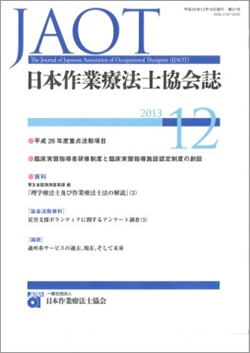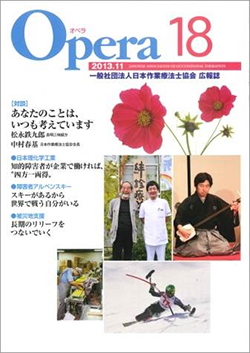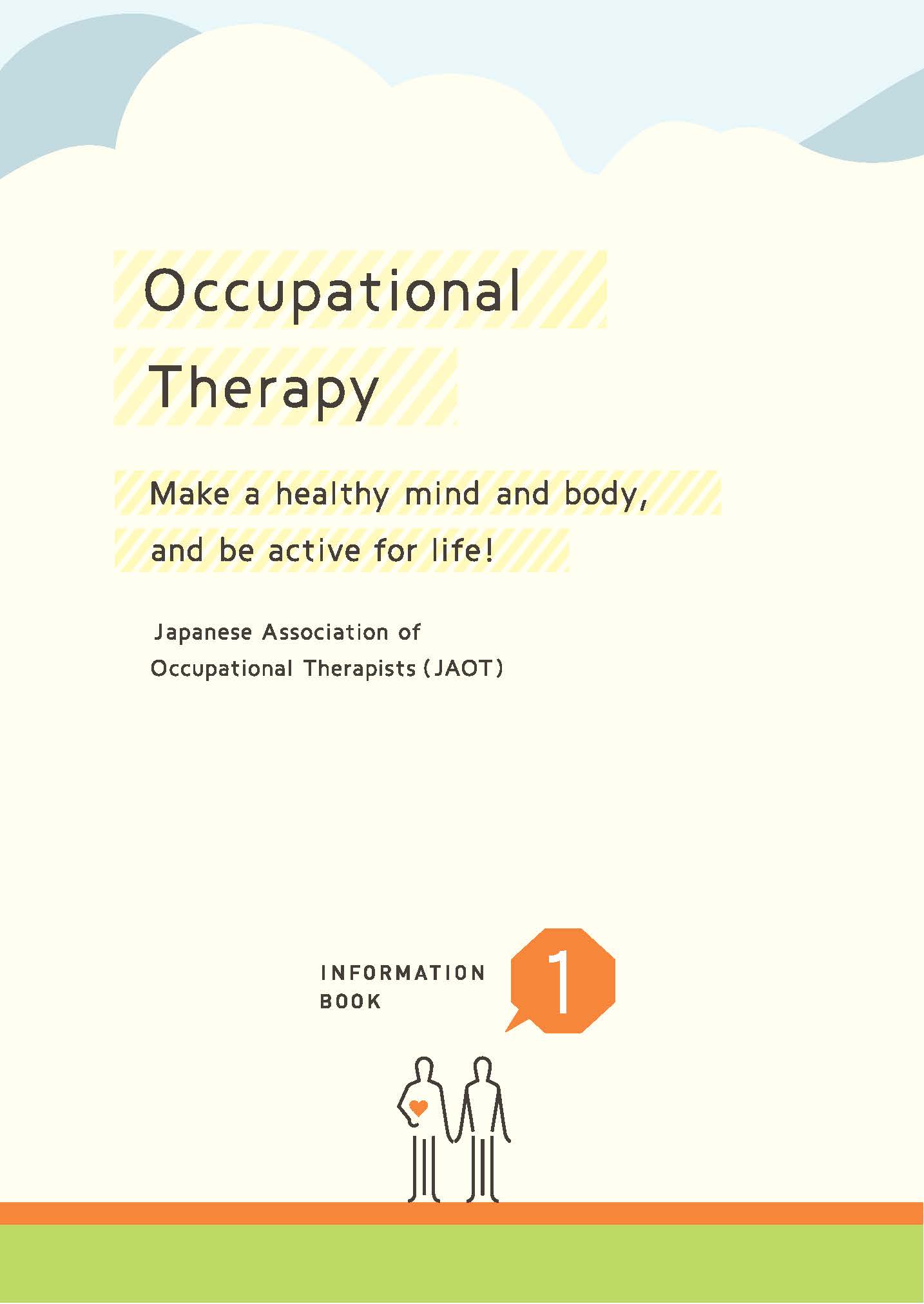Latest Topics
Departments and Activities of JAOT
Academic Department
- 1. Occupational Therapy Congress & Expo
- Annual congress involve about 4,000 participants and more than 1,000 oral and poster presentations are given.
2. Academic journal publication- Academic journal “Sagyouryouhou (Japanese Occupational Therapy Research)” is published 6 times a year, and English edition of “Asian Journal of Occupational Therapy” is issued annually. We publish reviewed research papers, providing a great opportunity for JAOT members and occupational therapists particularly in Asia to present their findings; we also post course announcements and other materials.
- 3. Case report recording system
- Practical cases of occupational therapy are collected from JAOT members via a dedicated computer system to compile materials presenting results of occupational therapy.
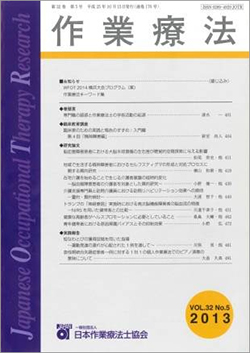
Sagyouryouhou (Japanese Occupational Therapy Research)
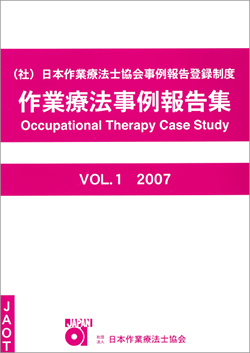
Occupational Therapy Case Study
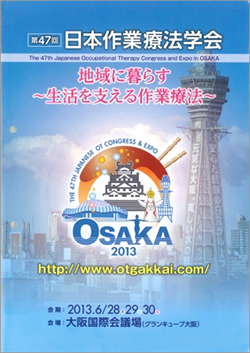
Japanese Occupational Therapy Congress program
- 4. Research grant system
- Research grants are provided for JAOT members to accumulate research results.
- 5. Development of ‘Occupational Therapy Guidelines’ and ‘Practical Instructions to Occupational Therapy Guidelines’
- Guidelines determining a framework of occupational therapy, and specific instructions related to clinical practice, have been developed and revised periodically.
- 6. Publication of ‘Occupational Therapy Manual’ series
- Aiming at upskilling of young occupational therapists, condition-specific manuals are compiled; 57 volumes were published up to now.
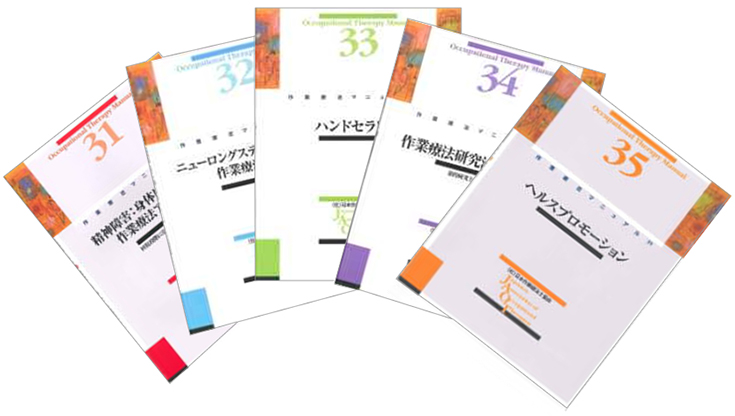
Occupational Therapy Manual
Education Department
- 1. Development and regular revision of ‘Minimum Standards for the Education of Occupational Therapists’
- We set standards to meet rules and teaching guidelines stipulated by the Ministry of Health, Labour and Welfare, and minimum standards by WFOT; the standards are revised periodically.
- 2. Operation of training system for clinical practice supervisors and certification system for clinical practice institutions
- These systems intended for training of competent supervisors for clinical practice and improvement of quality of training institutions were launched in 2013.
- 3. Analysis of national exam questions for occupational therapists and submission of written opinions
- Annual national exams for occupational therapists are post-analyzed, and written opinions (pointing out inappropriate questions etc.) are submitted.
4. Operation of Post-qualification Education System- A system of pre-qualification education has been established and operated aiming at self-improvement of occupation therapists, acquisition of new knowledge and skills, and licensing of authorized and specialized occupational therapists. (See next page).
5. Planning and running of various workshops- In 2013, we held 73 workshops including 2 national workshops for 300-400 participants, 30 workshops for authorized occupational therapists, 19 workshops for specialized occupational therapists, 18 workshops on priority issues, 2 workshops for educators, and 2 workshops for clinical practice supervisors.
6. Various certification procedures- We conduct various certification procedures such as teaching quality assessment according to WFOT standards, certification of authorized and specialized occupational therapists, etc.
JAOT POST-QUALIFICATION EDUCATION SYSTEM
Aiming at quality enhancement of occupational therapists, in 2003 Japanese Association of Occupational Therapists launched the existing system of post-qualification education. The first Association’s certification system for authorized occupational therapists was established in 2004, and then another certification system for specialized occupational therapists was established in 2009.
The post-qualification education includes ‘Post-qualification basic training program’ intended to support continued self-improvement of occupational therapists, ‘Certification program for authorized occupational therapists’ intended to acquire certain skills in occupational therapy in terms of clinical practice, education, research and management, and ‘Certification program for specialized occupational therapists’ intended to acquired advanced special skills in occupational therapy.
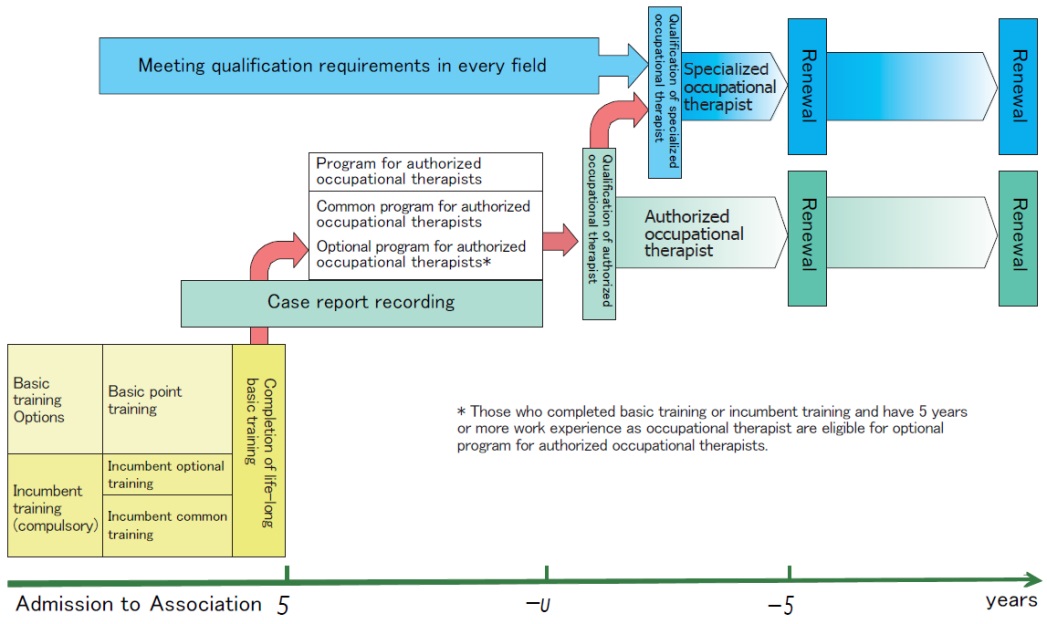
Structure of JAOT post-qualification education system 2013
Policy Department
- 1. Activities in medical insurance and long-term care insurance
- Aiming at promotion of placement of occupational therapists, higher remuneration, creation of new structures involving occupational therapists etc., we conduct surveys, compile basis documents, submit formal requests to Ministry of Health, Labour and Welfare and other related institutions, conduct negotiations, etc.
- 2. Activities in health and welfare of persons with disabilities
- Aiming at promotion of participation and involvement of occupational therapists, we conduct surveys, compile basis documents, submit formal requests to Ministry of Health, Labour and Welfare, Ministry of Education, Culture, Sports, Science and Technology and other related institutions, conduct negotiations, etc.
3. Activities in assistive technology and home renovation- Through development and operation of a system of advice and support regarding assistive technology, IT equipment rental service and other projects, we try to improve occupational therapists’ knowledge of assistive technology, and to improve services provided to citizens.
4. Publication of “A Guide on Medical Insurance, Long-Term Care Insurance and Welfare for Disabled Related to Occupational Therapy”- The guide explains legal grounds for activities of occupational therapists in Japan’s social security system. Particularly, detailed explanations are provided about standards for institution, conditions and points regarding remuneration for medical and nursing services, establishment and operation of facilities, etc.
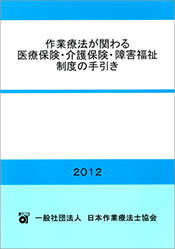
A Guide on Medical Insurance, Long-Term Care Insurance and Welfare for
Disabled Related to Occupational Therapy
Public Relations Department
- 1. Creation and distribution of various PR media
- We produce PR posters, various pamphlets, novelties, etc., and distribute them to promote occupational therapy.
2. Information Book- What is Occupational Therapy? Who benefits from Occupational Therapy? How can we become an Occupational Therapist? To answer those questions, JAOT published “Information Book 1”. The Book is provided to anyone who wants to learn or promote the awareness of occupational therapy, including occupational therapist schools, hospitals, and prefectural associations of occupational therapists.
3. Publication of Association journal- JAOT Journal is issued monthly and it contains event announcements, activity reports, important materials, other important information for members, etc.
4. Exhibition activities- We set up booths in International Home Care & Rehabilitation Exhibitions and other events, in cooperation with local organizations, to make citizens aware of occupational therapy as well as activities and importance of occupational therapists.
5. Holding occupational therapy forums- Workshops, symposiums and other events are planned and held to familiarize general public and other professionals with occupational therapy as well as activities and importance of occupational therapists.
International Affairs Department
- 1. Exchange with foreign occupational therapy associations
- We conclude agreement with foreign countries, particularly, neighbor Asian countries, on research, education and information, thus strengthening partnership and promoting exchanges.
2. Cooperation with World Federation of Occupational Therapists- We strengthen ties with WFOT officials, and introduce WFOT’s activities to our members.
3. Cooperation and exchange with international support organizations- We provide support to Japan Overseas Cooperation Volunteers, training opportunities for foreign occupational therapists, etc.
Disaster Prevention Office
- 1. Establishment of support system in case of wide-scale disaster
- We set up a support system including registration and training of volunteers, collaboration with local organizations, establishment of basic guidelines for support activities, compilation of various manuals, etc.
2. Providing support in case of wide-scale disaster- We provide financial help to affected areas as well as information support and manpower assistance including dispatch of disaster support volunteers.


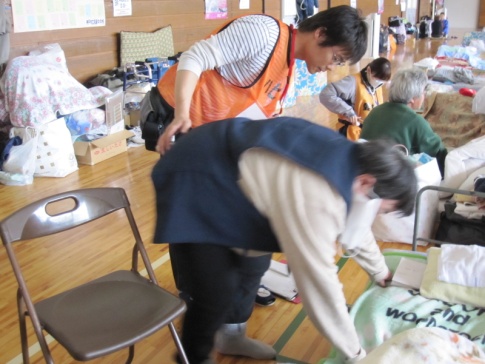
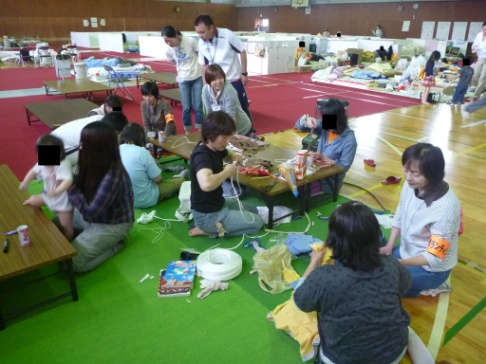
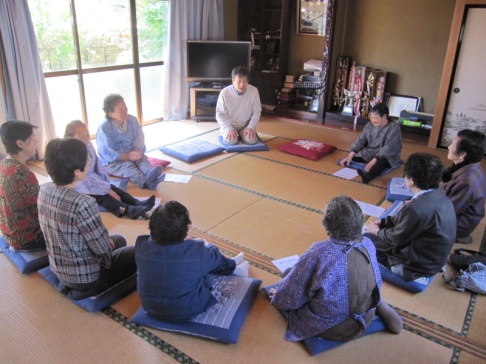
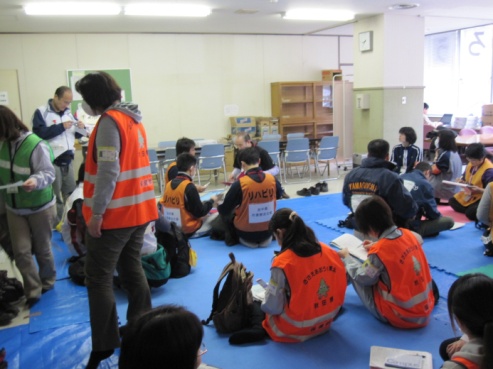
Efforts in 1st and 2nd Five-year Strategies for Occupational Therapy
Toward support for relocation and continuation of community living
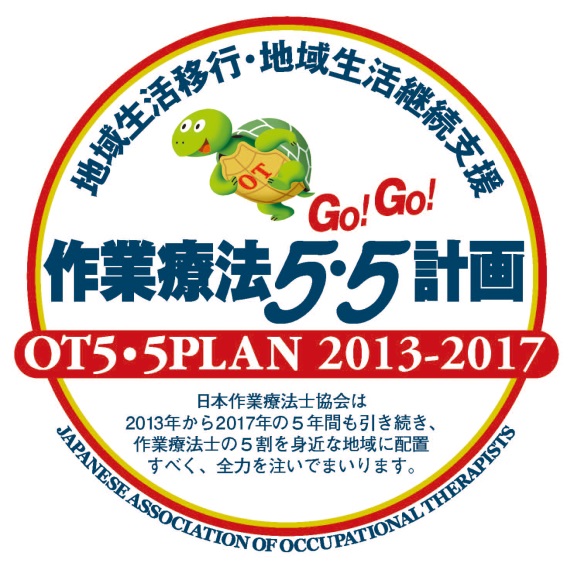
In 1995 population aging rate exceeded 14%, and Japan has become an aging society. With a peak in 2005, the total population began to decrease, and the rising population aging rate, determined by increase in expected life and decrease in youthful population because of the falling birth rate, poses such problems as elderly-to-elderly nursing care and dementia-to-dementia nursing care. According to a White paper issued by the Cabinet Office in 2009, 1 of 3 people we be elderly in 2035; in 2055, this proportion is expected to amount to 40.5%, and 1 of 2.5 citizens will be 65 or older, and 1 of 4 will be 75 or older.
This requires enhancement of medical services but at the same time, people’s everyday living should be supported as much as possible. Occupational therapy is required to support living functions of citizens, including those with disabilities. The role of occupational therapists is to help people to live their normal lives.
In 2007, Japanese Association of Occupational Therapists set a “Five-year Strategy for Occupational Therapy” for deployment of ‘occupational therapy for interrupted support at all stages from medical treatment toward community life’. The main target is to assign 50% of occupational therapists in the field of medical treatment (mostly, in-patient), and 50% in the field of community health, welfare and education, in 5 years. Continuation of this plan was approved in April 2013, and 2nd Five-year Strategy for Occupational Therapy, aiming at reinforcement of the role of occupational therapy in community-based integrated care system, was announced. This document provides a guideline for activities of Japanese Association of Occupational Therapists until 2017.
1. Enhanced Role in Community-Based Integrated Care System
In the situation described above, the Japanese Government promotes establishment of a local-based system that can provide an integrated daily support for medical treatment, nursing, prophylaxis, and living environment (community-based integrated care system) by 2025. Japanese Association of Occupational Therapists defines the role of occupational therapists in the community-based integrated care system, and demonstrates the core significance of this profession in community life support. One of main strategies is the response to Dementia Initial Intensive Support Team.
As explained above, dementia countermeasures are indispensable in Japan as the population ages increasingly. The Japanese Government announced placing ‘dementia initial intensive support teams’ in community-based integrated support centers etc.; such teams composed of doctors, nurses and occupational therapists have functions of ‘early support’ and ‘crisis prevention support’. The teams visit homes of people suspected of dementia, gather and evaluate information on living conditions, cognitive functions etc., and provide support to patients and their families, based on a proper diagnosis. Occupational therapists are expected to provide flexible response, professional assessment and appropriate support.
2. Support for Relocation and Continuation of Community Living in Fields of
Health, Education and Welfare for Disabled
1) Special Needs Education
In terms of enhancing core functions of special needs schools, the Japanese Government considers dispatching occupational therapists, physical therapists, speech therapists, psychologists and other specialists to such schools so as to improve overall professional level, and to provide support for children with disabilities. In this context, training of occupational pathologists for the field of education is mentioned as a future topic.
2) Support for Community Living (Particularly, for Work) in Field of Welfare for Disabled
Support for community living is important not only for elderly but also for physically and mentally disabled. In so doing, the role of occupational therapist is especially important in employment support. Such support includes ability evaluation, job matching, job coaching and other components; here occupational therapists can make a significant contribution, and it is important to promote placement in this field.
3. Occupational Therapy in Time of Disaster
After the Great Hanshin Earthquake and Great East Japan Earthquake, occupational therapists were in demand. When the latter occurred on March 11, 2011, many members were dispatched to the affected areas as participants of health-care teams or volunteers to provide disaster support. Besides, we were involved in fundraising, sending supplies and other relief activities. To this day, our members provide disaster support to the victims at provisional housing and homes, which includes mental care and assistance in employment.
Japanese Association of Occupational Therapists established a permanent Disaster Prevention Office so that occupational therapists can play an adequate role in case of disaster.

